Known by some as the magic lever that helps get an engine started, the choke is actually a pretty simple but essential mechanism.
Though it may seem a little bit mysterious at first, the choke on an engine works just as the name suggests. Most people know that setting a choke fully on gives the engine “more gas” but this only explains half of what really happens.
The way that choking an engine supplies more gas is by restricting the airflow into the carburetor (which is why it is called a choke).
Using the choke to get an engine started or warmed up is normal but if the lawn mower dies when the choke is off, something is probably wrong.
Why Does My Lawn Mower Only Run on Full Choke? (Short Answer)
Working on the fuel and air supply end of things, if your lawn mower only runs with the choke on, there is probably a fuel delivery or carburetor problem.
The main carburetor issues that cause this are air leaks, and clogging. Bad fuel or fuel with too high of an alcohol content can also require excessive choke use.
If you need to choke your engine for any longer than 5 minutes, you’ll know that something isn’t right.
This is true in any case whether you have a Kohler engine that only runs with the choke on or a Honda lawn mower that only runs with the choke on.
Possible Reasons Your Lawn Mower Dies When the Choke is Off
“Why does my lawn mower only run on full choke?!” is something many people find themselves muttering at some point or another.
What using the choke really does is enrich the fuel and air mixture that the engine uses to operate.
If your lawn mower dies when the choke is off, you’ll need to figure out why the engine isn’t getting the right ratio of fuel and air by itself.
I’ll describe the three most common reasons why this happens below.
Carburetor Problems
Carburetor clogging is probably the most common issue, especially when it comes to a 2 stroke engine that only runs with the choke on.
From gas turned to varnish, rusting, or debris in the fuel, carburetors can get clogged for any number of reasons.
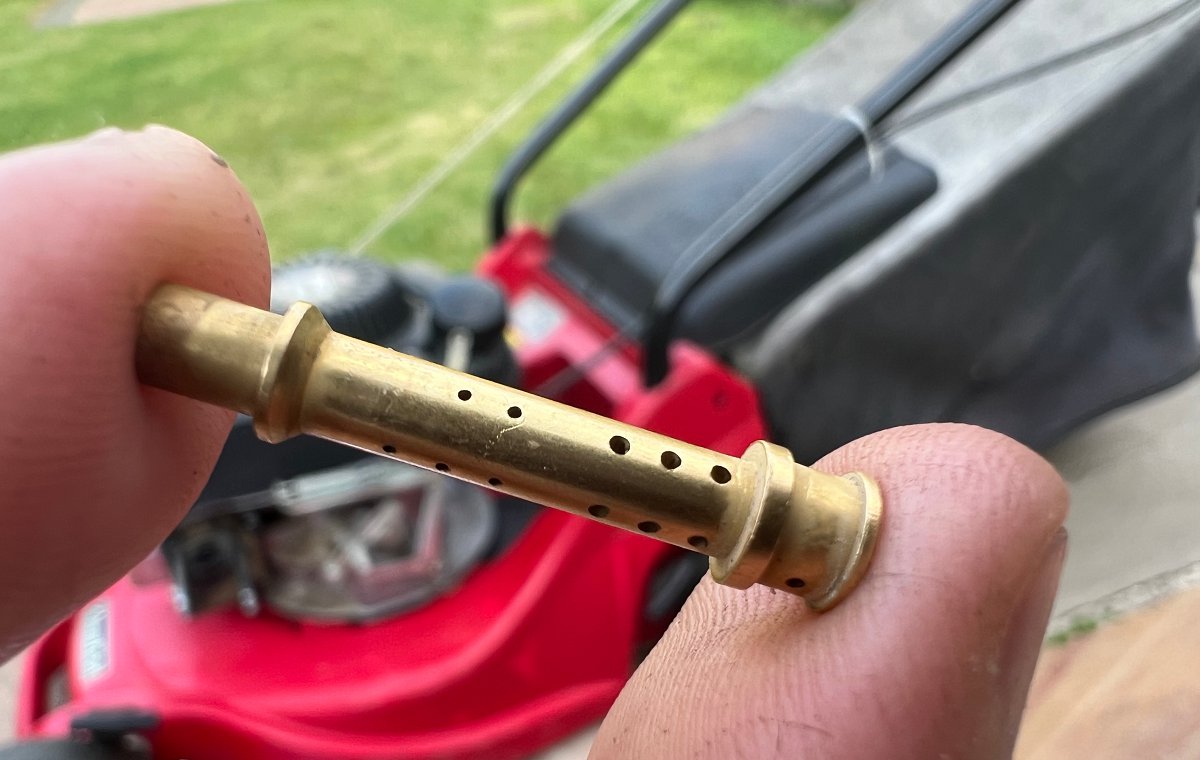
Inside of a carburetor, there are small jets with tiny holes that help deliver gas to the combustion chamber. Because they’re so small, they are easily blocked.
Probably the most common reason carburetors get gummed up is gas deterioration. Over time, gas that just sits will break down and coat the interior of the carburetor.
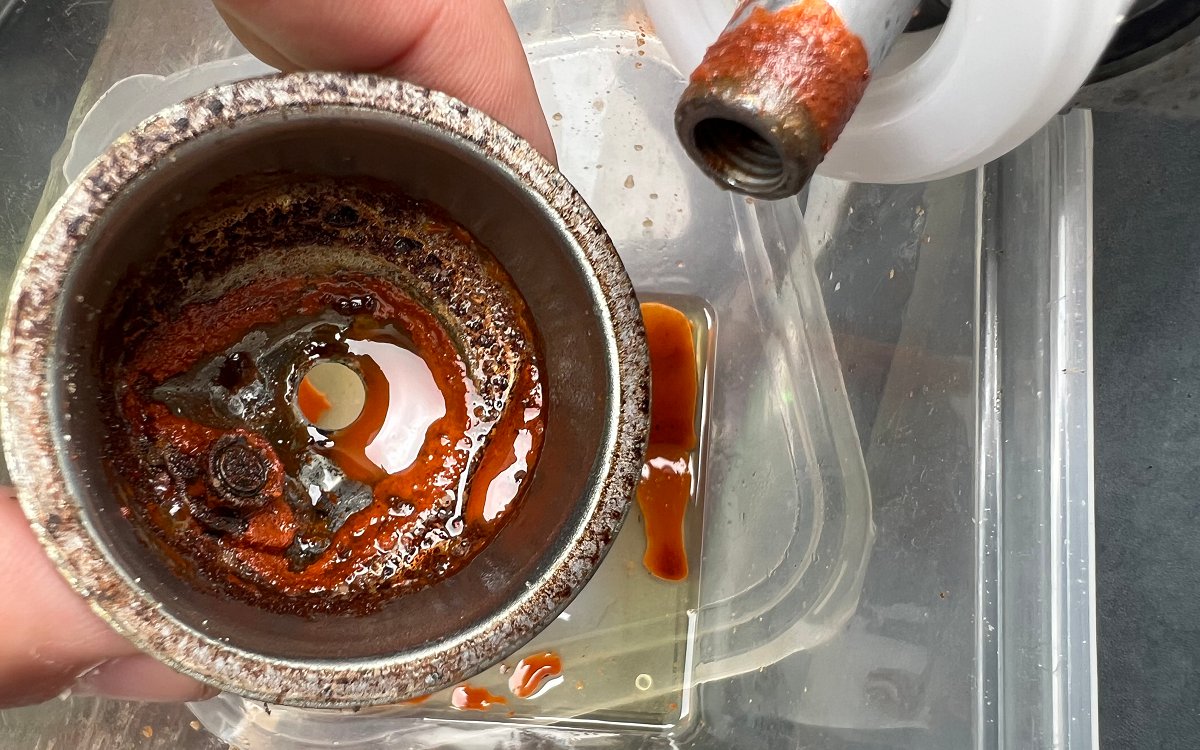
Carburetors work in a very precise way and if something is off they cannot supply a correct mixture of fuel and air alone.
This would create a situation where an engine or lawn mower only runs while choked, basically turning the choke into a clutch.
Air Supply Issues
When it comes to the fuel delivery system, air supply is super important. A choke works by restricting the air supply, increasing suction, and enriching the fuel and air mixture that enters the engine.
In other words, the choke forces more gas into the combustion chamber, helping engines start when cold.
While there are a few things that can throw off the amount of air that enters the engine, the main issues are: cracks or leaks in the fuel line or primer bulb, loose hardware or a carburetor air screw that is set wrong, and a gasket that isn’t seated right or is deteriorating.
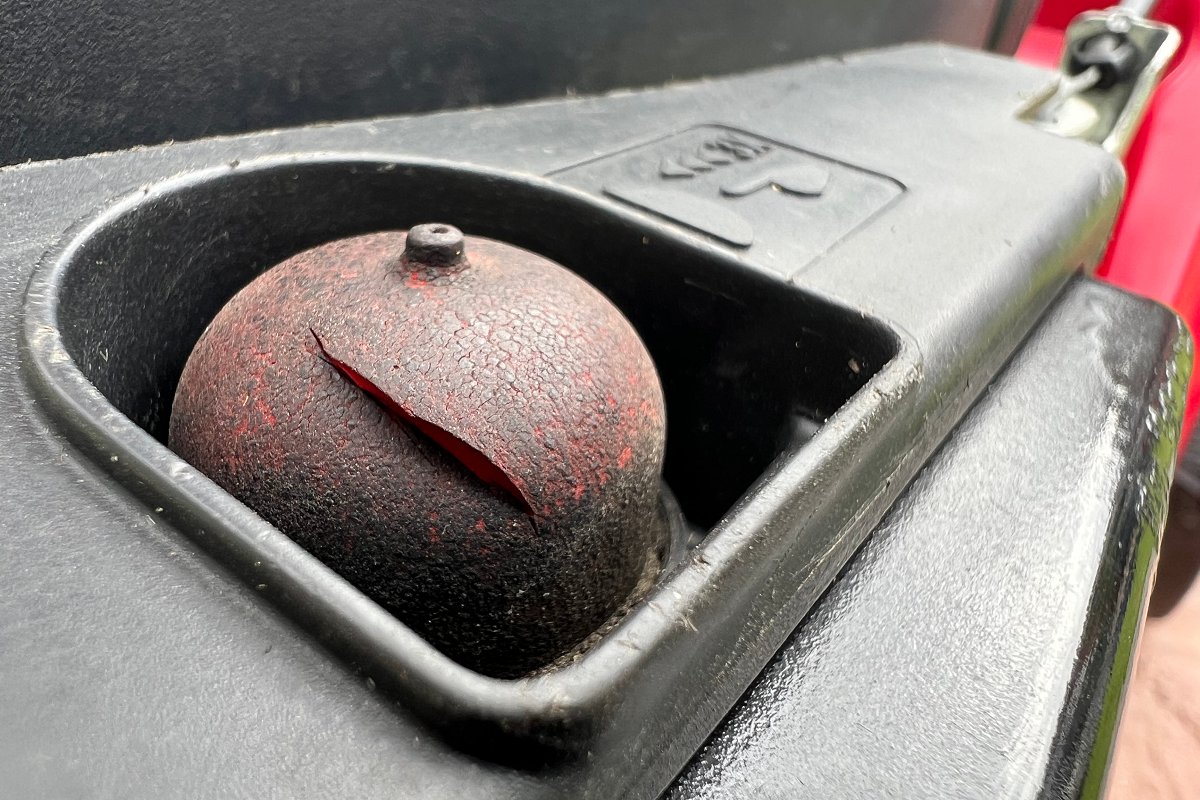
What these things have in common is that they can lead to excess air delivery and a weaker vacuum system. In all of these cases, the mower might be extra dependent on the choke to run.
Bad Fuel
Sometimes the problem is just that your fuel isn’t any good. This is usually due to using old gas or using the wrong type of gas.
Without any stabilizers, gasoline starts to break down pretty quickly (I wrote a separate post on how long gas lasts typically).
If your lawn mower has been sitting for more than a year without use, there is a possibility that the gas has gone bad.
If you’re not sure how to tell, read about the symptoms of bad gas in a lawn mower. They’re fairly easy to spot.

Also, you might have a type of gas in your tank that doesn’t agree with your mower’s engine.
Fuel with a high alcohol content like those with an ethanol blend will carry moisture and can lead to rust or a gunked-up carburetor.
In the United States, all regular gasoline is blended with ten percent ethanol. In larger engines, regular gas works great, but in smaller engines, it isn’t always the best choice.
Knowing which fuel you should use in your lawn mower is important if you want to avoid mechanical problems down the road.
How to Fix a Lawn Mower that Only Runs with the Choke On
Well, now that you have a good idea of why your lawn mower dies when the choke is off, let’s talk about how to fix it.
I’ll start with the most common fix and end with the rarest.
Clean or Replace the Carburetor
When deciding between these two options it really comes down to a couple of things: your experience with small engine work, and the price and availability of a new carburetor.
Being aware of the symptoms of a bad lawn mower carburetor can also come in handy too and help you understand whether a new carb is really necessary.
If you’re comfortable doing work on your lawn mower it actually isn’t too difficult to clean a carburetor.
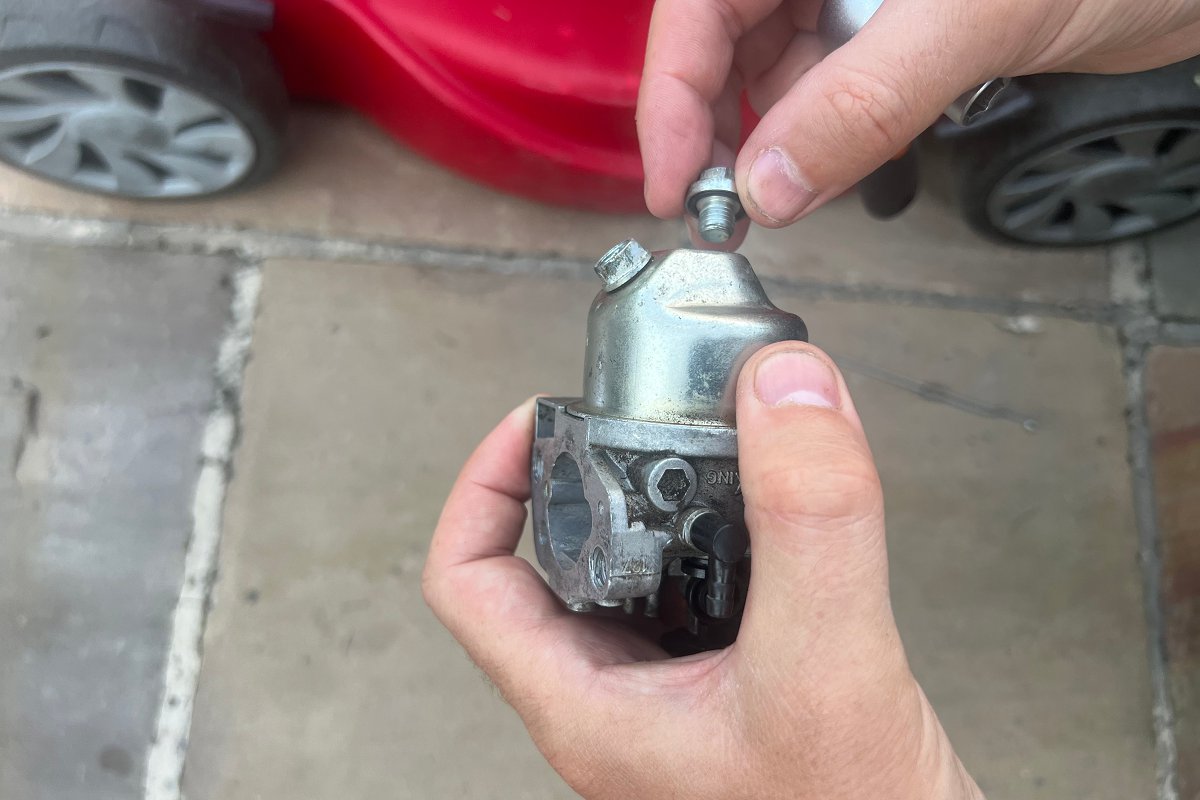
You’ll need to remove the carburetor and disassemble it. Just be sure to remember how it goes back together.
Sometimes you only need to spray carb cleaner through the jets and around the inside of the bowl. But, if your carburetor has a ton of varnished gas residue, you may need to soak the parts in the carburetor cleaner for a few hours.
Afterward, you just have to put the carburetor back together and reinstall it into the mower.
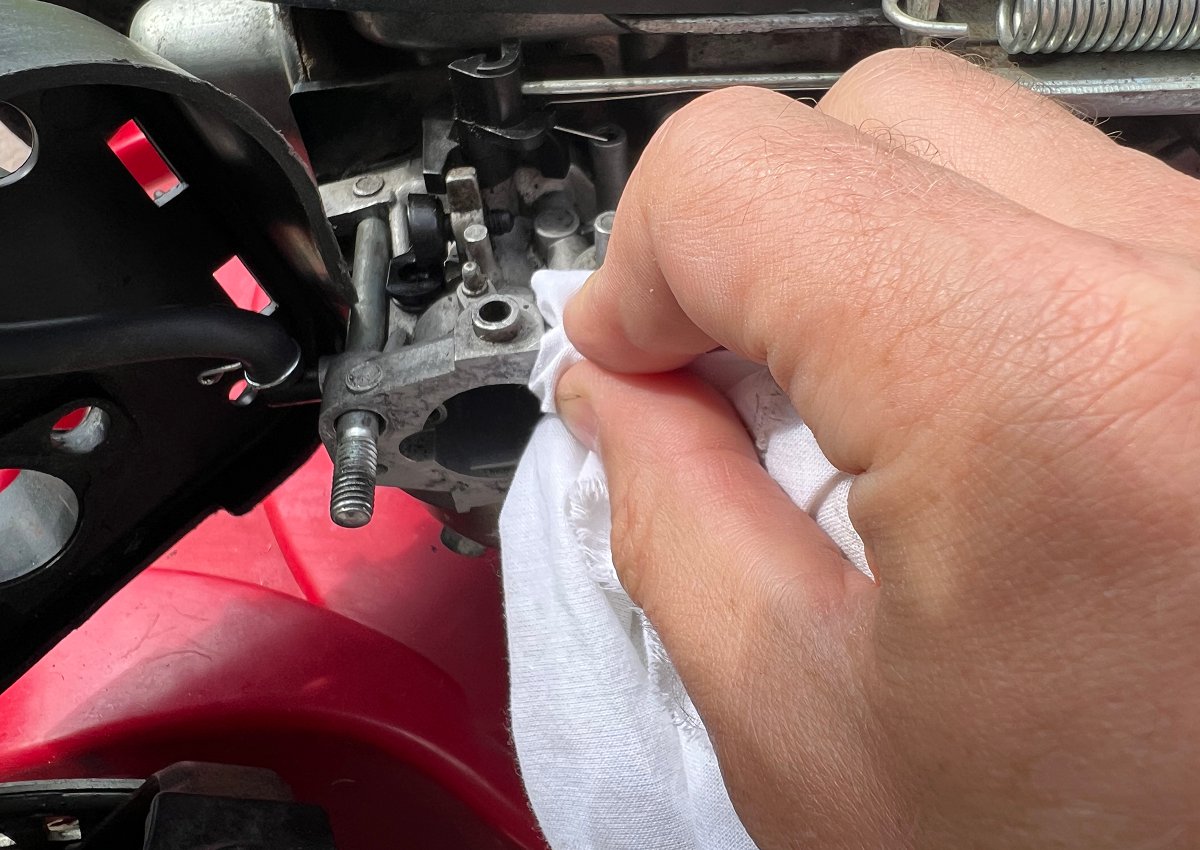
With that being said, if you have a carburetor that has rusted or is extremely gummed up, and you find an affordable new carburetor, you may be saving yourself a ton of time by going with a new part.
If you have any doubts, you can get some good advice at your local small engine mechanic’s shop.
Seal Air Leaks
The process of sealing air leaks looks different for every lawn mower. However, figuring out where the air supply has been disrupted is pretty straightforward.
Start by checking your fuel line for any cracks or connections that are loose. All of the vibration of a running lawn mower can be enough to wiggle a hose clamp off its seat.
If everything looks good, check your primer bulb. As these rubber bulbs age, they can get brittle and crack as well.
After making sure these rubber components are good, give your carburetor a once-over and make sure all the hardware is tightened down.
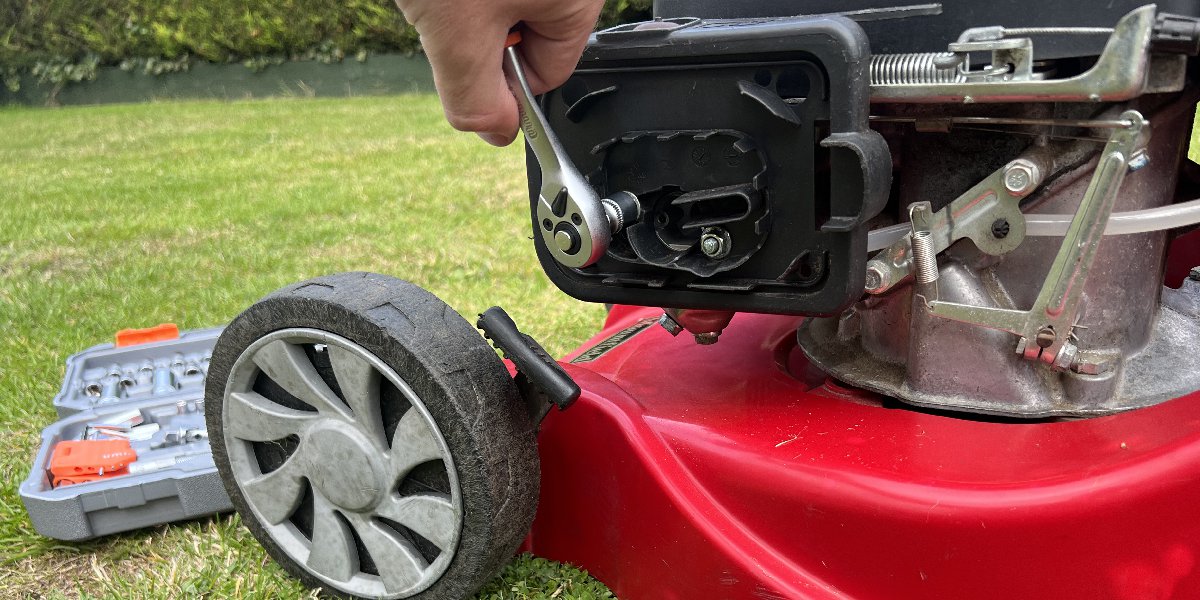
Also, when you’re checking out your carburetor try and see if anything looks off with the mounting gasket. If you see any edges of the gasket sticking out or it looks dried or cracked you’ll want to replace it.
Lastly, take a look at your fuel cap and make sure that it has a good seal on it still.
Use Different Fuel
Whether you have gas from the last season in your lawn mower, or you have used regular-grade gasoline, it might make all the difference to try premium or non-oxygenated gas.
If you aren’t sure if your gas has gone bad, take a look at its color. Gas that has gone bad usually has a darker color and sometimes even a sour smell.
If you have bad gas or just want to give new fuel a try, you’ll want to siphon or drain out the rest of the fuel in your tank (here’s how to drain gas from your mower without a siphon).
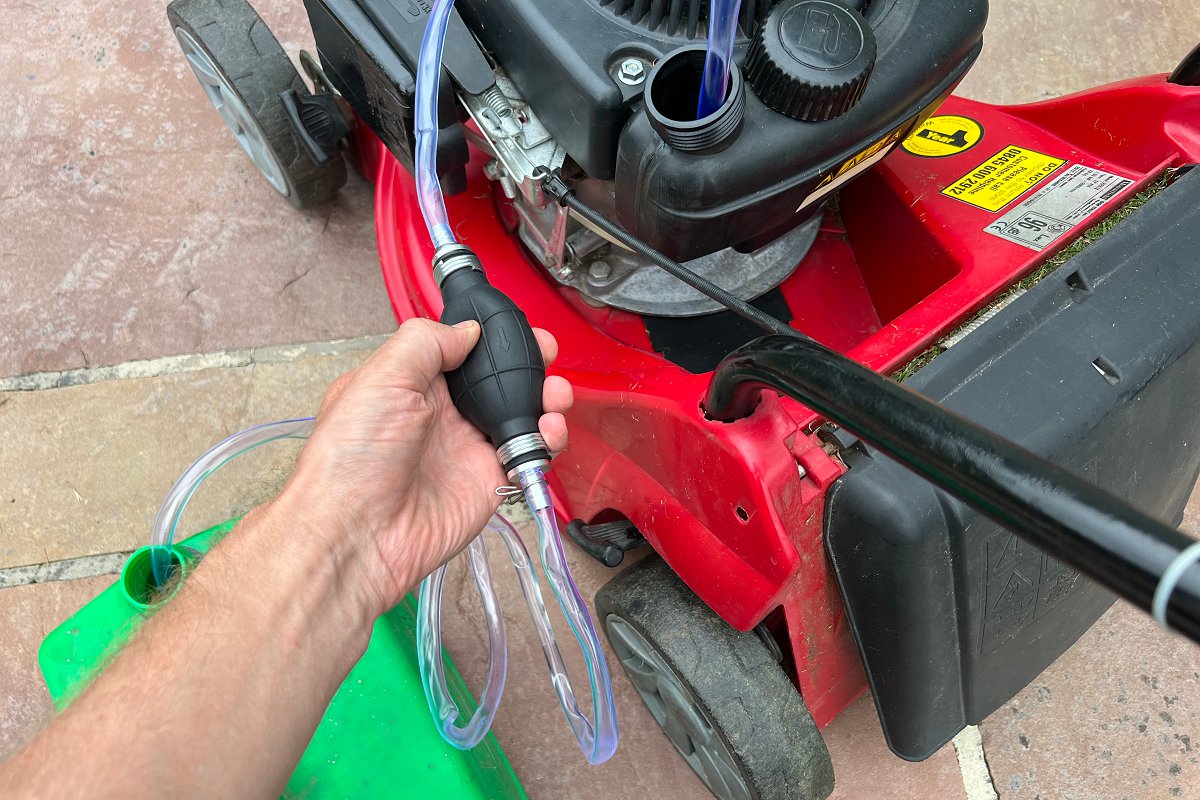
If you drain it out by tipping the mower over just make sure you keep your carburetor and air filter facing up when doing so.
Using high-quality fuel can help extend your mower’s life and a riding lawn mower that only runs with the choke on might benefit from premium gas in particular.
If you’ve made the investment in a riding mower, do yourself a favor and do everything you can to keep its engine happy.

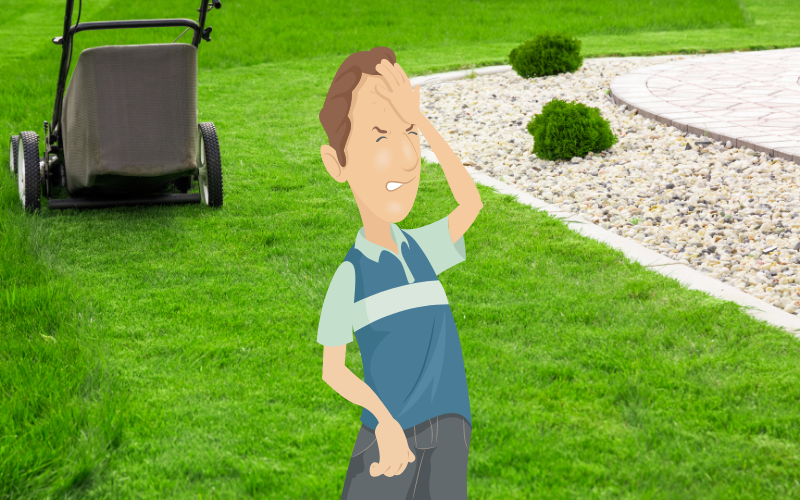

Hello, I noticed that you mentioned to check gas cap for good seal. My husqvarna will only run choked, however the gas tank itself has crack in the top of it. After gas sloshed inside tank a bit I noticed leaked gas on top of tank under the seat. Could this be the cause. Already replaced/checked fuel lines, filter, pump, and a couple gaskets. The other thing I’m suspicious about is where the governer assembly is there appears to be a piece of plastic that’s dangling off the rod or arm that seems like it might be something that broke, not sure (very little engine experience). Would appreciate your thoughts. Thanks, Jared.
Hello Jared!
Whether or not your cracked fuel tank is the source of your problems, it is something that you should fix right away. Gas fumes leaking up underneath your seat can be a pretty serious fire hazard. Luckily it isn’t a super hard fix. However you do it, it helps to start by drilling tiny holes on either end of the crack so that the crack won’t get any bigger.
As far as your mower only running with the choke on goes, I think you’ve made some steps in the right direction. The remaining boxes to check would be trying fresh fuel, and cleaning out your carburetor. I think that carburetor issues are some of the most common.
Regarding that piece of plastic dangling, it sounds to me like you could be describing a pneumatic governor. A pneumatic governor should have a piece of plastic that dangles and also two springs: one attached to the throttle, and one to the carburetor. If the governor assembly is messed up, that could definitely affect how the choke is used.
Hope this clears things up a little bit. I would probably investigate your carburetor first.
Tom.
That’s the most straight forward explanation and fix I’ve seen. Thanks.
Glad you found it useful and easy to follow, Edward 🙂
You are a clear teacher. Thank you. My Honda Inverter doesn’t get used very often. I live near the ocean and everything than can rust does rust. Like within the hour. Recently the engine started but died immediately, with or without choke. After draining gas and putting in a cup of “fixit gas” the engine started and ran smoothly ON THE FIRST PULL. I had also drained carburetor bowl and checked spark plug. While plug was out I pulled cord a few times. My manuals says there’s a fuel pump and that would clear gas from it. I didn’t notice any gas come out. Kinda weird. As I stood there congratulating myself for “fixing” the generator (even though I had no idea how it got fixed) I noticed the choke was on. Opening the choke caused the engine to die immediately. But it runs beautifully w choke on, in regular mode and “eco mode”. 🤷🏼♂️
My John Deere x500 only runs with choke on and is hard to start. It shuts down while cutting grass. I installed a new fuel pump and new carb. Still the same problem. I’m going to check fuel line from the tank, but there is gas in the filter. What do you think of this?
Hi Jim,
Have you tried to run the tractor on low RPM?
Usually, if the engine is being starved of gas, it’s a bigger problem when the demand is higher (high RPM). So, if the mower keeps running on low RPM and then stalls when you increase the RPM and add load, it could definitely be starved of fuel.
The engine can be starved of fuel in the following ways:
Blockage in the fuel tank
Clogged fuel line
Blocked fuel filter
Incorrect fuel filter
Poor fuel pressure (check the pipe from the OHV to the fuel pump)
Clogged fuel cap
Pinched fuel lines
If you have just installed a new carb, then we can only hope that the factory’s air-to-fuel mixture setting is correct. If you have to play with the choke, then you’re manually adjusting the mixture. Choking is giving more fuel, so there’s not enough fuel or too much air. I’m guessing you already looked at the air filter.
I hope this gives you a few ideas.
Cheers, Tom.
Have a 46” XLT cub cadet that has been used regularly, but has been set out, year round, uncovered for 5 years. Stopped running and the owner bought a new replacement zero turn. He gave me the cadet. I cleaned the carb, changed the oil, air filters, plugs and inline fuel filter. One of the two coils was bad and I replaced both with new ones. Before doing all this, it would crank good, run 1.5-2 minutes, and cutoff. Could prolong the running, by working the choke. Obviously, the hotter it got, the more difficult it was to keep it running. The mower is tight and I think would be quite serviceable if I could keep it running. Do you have suggestions on what else I need to try to solve my problems? Thanks in advance.
Hi Dan,
Well, it looks like you have covered most of the bases and serviced everything that you can. So, I’d be looking back at the carburetor. If you can keep the engine running with the choke, then you’re changing the air-to-fuel mixture and giving the engine a little more fuel. This means there is either an issue with the fuel coming in, the air coming in, or the way the fuel is being mixed and then ejected out of the carburetor’s jet. These are items I would want to inspect.
Fuel Filter
Fuel Lines
Fuel Pump
Air Filter
Carburetor Jet & Float
Carburetor Settings
I’d try running the engine on idle to see if it stalls. If it only stalls at high speed, it looks like the engine is being starved of fuel. I hope you find where the problem lies and get the cub running again.
Good luck!
Cheers, Tom.
My Toro backpack leaf blower is 14 years old. I just replaced the carb and spark plug but it still only runs with choke 1/2 on. After replacing the carb it now only runs for awhile then bogs down and dies. Could it be as simple as a bad fuel filter ? I only run fresh, 90 octane, ethenol free gas .
Hi Marty,
14 years, impressive! I have an old Stihl blower that belongs in a museum. I had a similar problem with it like the one you seem to be having. I would make sure that the in-tank fuel filter is replaced and take a look at the fuel lines. It doesn’t take much to give them a problem as they are so tiny.
Also, I had to replace the washer on the fuel cap as the tank couldn’t pressurize and push fuel to the carb. One trick I found was to put my hand over the end of the pipe the air of the blow comes out of for a few seconds. This forces the RPM to increase and keeps the engine running. I’m guessing that you have changed out the air filter and that the new carb is already pre-set with air-to-fuel mix.
Finally, the piston rings and pistons can wear causing a loss of compression in the engine. If this is the case then it could be time to finally retire the blower.
I hope this gives you a few ideas!
Cheers, Tom.
I have a 19hp Kohler zero turn which was hard starting. I replaced the carb with off-brand, new plug, new air and fuel filter, and all new gas lines. It starts great now but I have to let it run at low rpm for a minute then increase rpm for a couple of minutes before engaging the blades or it will stall. It didn’t do this before the new carb. Could be air and fuel mixture or maybe the governer. I tried adjusting the air and fuel mixture screw but not sure where to set it. Or could it be the way the new carb is as it runs great after it warms up?
Hi Ed,
It sounds like your Kohler is struggling with the initial load at low RPM. This would make me think that the Idle RPM is set too low or that the carb-low setting/screw needs to be increased.
Your comment about the fact it’s not an OEM part also could be a factor. Maybe have a read of the reviews on the part. Other people could be having the same problem with that particular part.
Another thing you mentioned was the governor. I would check the old carb with the new one. If the link bar between the carb and the governor is different on the two carbs, then you may need to compensate and make some small adjustments.
I hope this gives you a few ideas!
Cheers, Tom.
Hi Tom, I have a sears snow blower four stroke. It starts right up and run perfect till I take the choke off. I installed a factory carburetor for second time. I verify the carburetor is not the issue unless Briggs and Stratton are having issues. It does not come with a new o ring and I see no issues with original. What do u think? I will definitely check the primer. Never was aware this would affect the engine. No mixture adjustment.
Hi Lou,
So, a correctly installed new non-adjustable carburetor with a manual choke. Well, I would want to look at fuel delivery and air delivery. For example, you want to make sure that there is no kind of blockage preventing fuel from flowing through the fuel lines, fuel filter, fuel pump, and any air restriction through the air filter.
Also, I would want to make sure that the pulse pressure from the OHV is working. That’s if your snow blower uses a pulse fuel pump. If you have some kind of blockage or a split in one of your hoses (including the primer), then air could be getting sucked into the fuel throwing off the air/fuel mixture. I would be interested to know if the engine struggles on low RPMS as well as high RMPS. If it’s just high RPMS, then it is likely the engine isn’t getting enough fuel.
I hope this gives you a few ideas of what to look at.
Thanks for the question.
Tom.
thank you for the information